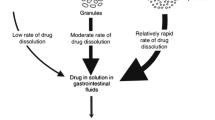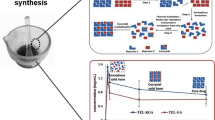Abstract
The aim of this study was to apply quality by design (QbD) for pharmaceutical development of felodipine solid mixture (FSM) containing hydrophilic carriers and/or polymeric surfactants, for easier development of controlled-release tablets of felodipine. The material attributes, the process parameters (CPP), and the critical quality attributes of the FSMs were identified. Box–Behnken experimental design was applied to develop space design and determine the control space of FSMs that have maximum solubility, maximum dissolution, and ability to inhibit felodipine crystallization from supersaturated solution. Material attributes and CPP studied were the amount of hydroxypropyl methylcellulose (HPMC; X 1), amount of polymeric surfactants Inutec®SP1 (X 2), amount of Pluronic®F-127 (X 3) and preparation techniques, physical mixture (PM) or solvent evaporation (SE; X 4). There is no proposed design space formed if the Pluronic® content was below 45.1 mg and if PM is used as the preparation technique. The operating ranges, for robust development of FSM of desired quality, of Pluronic®, Inutec®SP1, HPMC, and preparation technique, are 49–50, 16–23, 83–100 mg, and SE, respectively. The calculated value of f2 was 56.85, indicating that the release profile of the controlled-release (CR) tablet (CR-6) containing the optimized in situ-formed FSM was similar to that of the target release profile. Not only did the ternary mixture of Pluronic®, HPMC with Inutec®SP1 enhance the dissolution rate and inhibit crystallization of felodipine, but also they aided Carbopol®974 in controlling felodipine release from the tablet matrix. It could be concluded that a promising once-daily CR tablets of felodipine was successfully designed using QbD approach.











Similar content being viewed by others
References
Nasr M. FDA’s quality initiatives: an update. http://www.gmpcompliance.com/daten/download/FDAs_Quality_Initiative.pdf. Accessed 18 Nov 2010.
Food and Drug Administration CDER. Guidance for industry, Q8 (R2) pharmaceutical development (November 2009).
Yu LX. Pharmaceutical quality by design: product and process development, understanding, and control. Pharm Res. 2008;25(4):781–91.
Lee KR, Kim EJ, Seo SW, Choi HK. Effect of poloxamer on the dissolution of felodipine and preparation of controlled release matrix tablets containing felodipine. Arch Pharm Res. 2008;31(8):1023–8.
Kerc J, Srcic S, Knez Z, Sencar-Bozic P. Micronization of drugs using supercritical carbon dioxide. Int J Pharm. 1999;182(1):33–9.
Karavas E, Ktistis G, Xenakis A, Georgarakis E. Miscibility behavior and formation mechanism of stabilized felodipine-polyvinylpyrrolidone amorphous solid dispersions. Drug Dev Ind Pharm. 2005;31(6):473–89.
Karavas E, Georgarakis E, Sigalas MP, Avgoustakis K, Bikiaris D. Investigation of the release mechanism of a sparingly water-soluble drug from solid dispersions in hydrophilic carriers based on physical state of drug, particle size distribution and drug–polymer interactions. Eur J Pharm Biopharm. 2007;66(3):334–47.
Kim EJ, Chun MK, Jang JS, Lee IH, Lee KR, Choi HK. Preparation of a solid dispersion of felodipine using a solvent wetting method. Eur J Pharm Biopharm. 2006;64(2):200–5.
Vogt M, Kunath K, Dressman JB. Dissolution improvement of four poorly water soluble drugs by cogrinding with commonly used excipients. Eur J Pharm Biopharm. 2008;68:330–7.
Konno H, Taylor LS. Influence of different polymers on the crystallization tendency of molecularly dispersed amorphous felodipine. J Pharm Sci. 2006;95(12):2692–705.
Konno H, Taylor LS. Ability of different polymers to inhibit the crystallization of amorphous felodipine in the presence of moisture. Pharm Res. 2007;25(4):969–78.
Konno H, Handa T, Alonzo DE, Taylor LS. Effect of polymer type on the dissolution profile of amorphous solid dispersions containing felodipine. Eur J Pharm Biopharm. 2008;70:493–9.
Motwani SK, Chopra S, Talegaonkar S, Kohli K, Ahmad FJ, Khar RK. Chitosan-sodium alginate nanoparticles as submicroscopic reservoirs for ocular delivery: formulation, optimisation and in vitro characterisation. Eur J Pharm Biopharm. 2008;68(3):513–25.
Won DH, Kim MS, Lee S, Park JS, Hwang SJ. Improved physicochemical characteristics of felodipine solid dispersion particles by supercritical anti-solvent precipitation process. Int J Pharm. 2005;301(1–2):199–208.
Khan KA. The concept of dissolution efficiency. J Pharm Pharmacol. 1975;27(1):48–9.
Furlanetto S, Cirri M, Maestrelli F, Corti G, Mura P. Study of formulation variables influencing the drug release rate from matrix tablets by experimental design. Eur J Pharm Biopharm. 2006;62:77–84.
Janssens S, Humbeeck JV, Van den Mooter G. Evaluation of the formulation of solid dispersions by co-spray drying itraconazole with Inutec SP1, a polymeric surfactant, in combination with PVPVA 64. Eur J Pharm Biopharm. 2008;70(2):500–5.
Chutimaworapan S, Ritthidej GC, Yonemochi E, Oguchi T, Yamamoto K. Effect of water-soluble carriers on dissolution characteristics of nifedipine solid dispersions. Drug Dev Ind Pharm. 2000;26(11):1141–50.
Chen J, Qiu L, Hu M, Jin Y, Han J. Preparation, characterization and in vitro evaluation of solid dispersions containing docetaxel. Drug Dev Ind Pharm. 2008;34(6):588–94.
Van den Mooter G, Weuts I, De Ridder T, Blaton N. Evaluation of Inutec SP1 as a new carrier in the formulation of solid dispersions for poorly soluble drugs. Int J Pharm. 2006;316(1–2):1–6.
Ghebremeskel AN, Vemavarapu C, Lodaya M. Use of surfactants as plasticizers in preparing solid dispersions of poorly soluble API: selection of polymer–surfactant combinations using solubility parameters and testing the processability. Int J Pharm. 2007;328(2):119–29.
Matsumoto T, Zografi G. Physical properties of solid molecular dispersions of indomethacin with poly(vinylpyrrolidone) and poly(vinylpyrrolidone-co-vinyl-acetate) in relation to indomethacin crystallization. Pharm Res. 1999;16(11):1722–8.
Simonelli AP, Mehta SC, Higuchi WI. Dissolution rates of high energy sulfathiazole–povidone coprecipitates II: characterization of form of drug controlling its dissolution rate via solubility studies. J Pharm Sci. 1976;65(3):355–61.
Suzuki H, Sunada H. Influence of water-soluble polymers on the dissolution of nifedipine solid dispersions with combined carriers. Chem Pharm Bull (Tokyo). 1998;46(3):482–7.
Raghavan SL, Trividic A, Davis AF, Hadgraft J. Crystallization of hydrocortisone acetate: influence of polymers. Int J Pharm. 2001;212(2):213–21.
Usui F, Maeda K, Kusai A, Nishimura K, Yamamoto K. Inhibitory effects of water-soluble polymers on precipitation of RS-8359. Int J Pharm. 1997;154:59–66.
Khan GM, Jiabi Z. Formulation and in vitro evaluation of ibuprofen-Carbopol 974P-NF controlled release matrix tablets III: influence of co-excipients on release rate of the drug. J Control Release. 1998;54(2):185–90.
Rodriguez CF, Bruneau N, Barra J, Alfonso D, Doelker E. Hydrophilic cellulose derivatives as drug delivery carriers: influence of the substitution type on the properties of compressed matrix tablets. In: Wise DL, editor. Handbook of pharmaceutical controlled release technology. New York, USA: Marcell Dekker; 2000. p. 1–30.
Maggi L, Bruni R, Conte U. High molecular weight polyethylene oxides (PEOs) as an alternative to HPMC in controlled release dosage forms. Int J Pharm. 2000;195(1–2):229–38.
Ozeki T, Yuasa H, Kanaya Y. Controlled release from solid dispersion composed of poly(ethylene oxide)-carbopol interpolymer complex with various cross-linking degrees of carbopol. J Control Release. 2000;63(3):287–95.
Aboelwafa AA, Basalious EB. Optimization and in vivo pharmacokinetic study of a novel controlled release venlafaxine hydrochloride three-layer tablet. AAPS Pharm Sci Tech. 2010;11(3):1026–37.
Author information
Authors and Affiliations
Corresponding author
Additional information
Guest Editors: Michael Repka, Joseph Reo, Linda Felton, and Stephen Howard
Rights and permissions
About this article
Cite this article
Basalious, E.B., El-Sebaie, W. & El-Gazayerly, O. Application of Pharmaceutical QbD for Enhancement of the Solubility and Dissolution of a Class II BCS Drug using Polymeric Surfactants and Crystallization Inhibitors: Development of Controlled-Release Tablets. AAPS PharmSciTech 12, 799–810 (2011). https://doi.org/10.1208/s12249-011-9646-6
Received:
Accepted:
Published:
Issue Date:
DOI: https://doi.org/10.1208/s12249-011-9646-6




